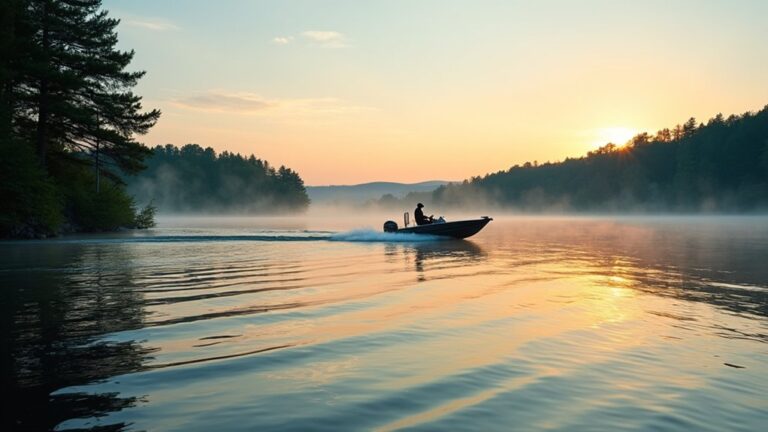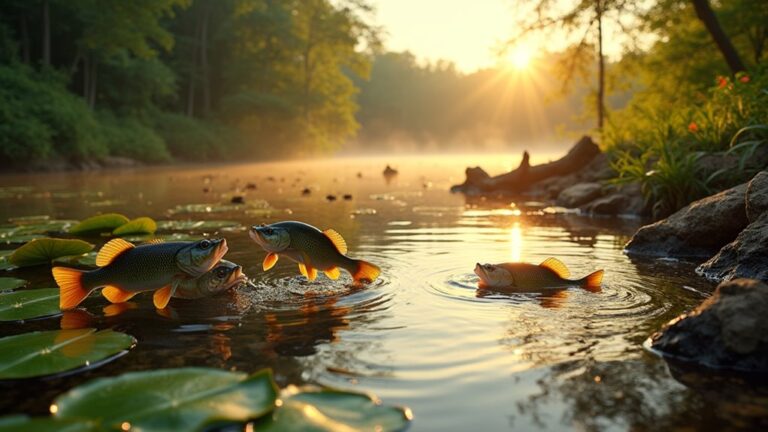You'll find a diverse array of freshwater fish in the Northeast's lakes, rivers, and ponds. Largemouth and smallmouth bass are popular game fish, known for their fighting spirit. Bluegills and pumpkinseed sunfish add vibrant colors to the waters. Channel catfish and brown bullheads thrive in warmer, murkier environments. Yellow perch are a favorite among ice fishing enthusiasts. Rainbow trout prefer cold, clear streams, while chain pickerel lurk in weedy areas. These species offer unique challenges and rewards for anglers. Explore further to uncover the fascinating traits and habitats of these common Northeastern fish.
Largemouth Bass
One of the Northeast's most popular freshwater fish, the Largemouth Bass, thrives in quiet, weedy waters. You'll find these sought-after game fish in shallow bays, small lakes, and ponds throughout the region.
With an average length of 13 inches and a lifespan of up to 15 years, they're a substantial catch for any angler. Ideal fishing for largemouth bass typically occurs during early morning and late evening, when they're most active, especially in warmer months when ideal fishing conditions can lead to impressive catches.
If you're planning to fish for largemouth bass, timing is essential. They spawn in late spring, with eggs hatching in just 3 to 5 days. As opportunistic feeders, they'll bite on a variety of lures mimicking their natural prey: fish, invertebrates, and amphibians. This diverse diet contributes to their adaptability and widespread success.
You can't miss a largemouth bass's distinctive large mouth, which gives them their name and helps them engulf prey. Their fighting ability makes them a favorite target for recreational anglers, who often employ various fishing techniques to land these prized catches.
Whether you're casting topwater lures, working soft plastics, or trying your hand at fly fishing, the largemouth bass offers an exciting challenge for anglers of all skill levels.
Bluegill
While often overlooked in favor of larger game fish, the Bluegill plays a crucial role in Northeastern freshwater ecosystems. As an important species for pond and lake management, it helps control populations of crustaceans and insects. You'll find these vibrant, round-shaped fish averaging 8 inches in length, with their colors becoming especially striking during breeding season.
Bluegills are a favorite among anglers due to their abundance and willingness to bite. Whether you're a novice or experienced fisher, you'll likely encounter these common freshwater fish. They typically live up to 10 years and spawn in early summer, creating nests near the shoreline for their eggs.
Here's a quick overview of the Bluegill:
| Characteristic | Description |
|---|---|
| Scientific Name | Lepomis macrochirus |
| Average Length | 8 inches |
| Lifespan | Up to 10 years |
| Diet | Invertebrates, small fish |
As key players in the aquatic food web, Bluegills primarily feed on invertebrates and small fish. Their role in maintaining ecosystem balance, combined with their popularity among anglers, makes them a significant species in Northeastern freshwater habitats.
Channel Catfish
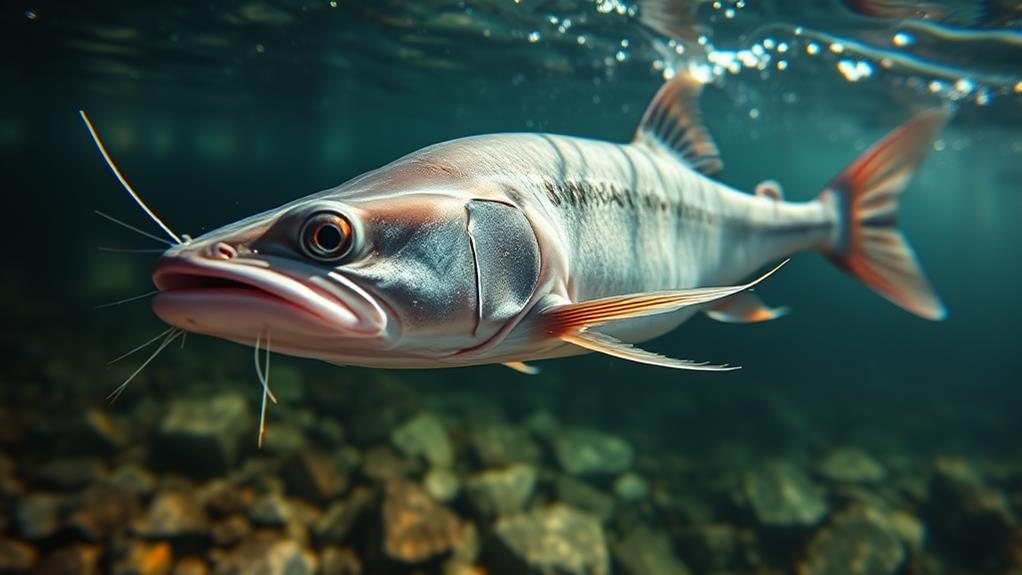
Frequently encountered in Northeastern waters, the Channel Catfish (Ictalurus punctatus) is a popular recreational fish that's easily recognized by its distinctive whiskers, called barbels.
You'll find these fish growing to an average length of 15 to 24 inches, with some individuals living up to 15 years.
Channel Catfish thrive in various freshwater habitats, including rivers, lakes, and ponds. They're often found near structures or cover, which provide them with shelter and hunting grounds.
These adaptable fish have a diverse diet, primarily feeding on small fish, crustaceans, clams, snails, and aquatic insects.
If you're an angler, you'll enjoy targeting Channel Catfish. They're a favorite catch among fishing enthusiasts, who often use baits like chicken liver, stink bait, and nightcrawlers to lure them in.
Keep in mind that their spawning season typically occurs in May, with reproduction in ponds being limited.
As you explore Northeastern waters, you'll likely encounter these whisker-faced fish. Their ability to adapt to different environments and their varied diet make them a fascinating species to observe and catch in the region's diverse aquatic ecosystems.
Yellow Perch
Another popular freshwater fish you'll encounter in the Northeast is the Yellow Perch (Perca flavescens).
These vibrant fish thrive in various freshwater habitats, including lakes, ponds, and rivers. You'll often spot them lurking near submerged vegetation, which provides both shelter and hunting grounds.
Yellow perch typically grow to 8-10 inches in length and can live up to a decade in the wild. As opportunistic feeders, they'll consume a variety of prey, including small fish, aquatic insects, and crustaceans. This adaptable diet contributes to their widespread success in northeastern waters.
If you're an angler, you'll appreciate yellow perch for their mild flavor and sporting qualities. They're a favorite among both recreational and ice fishing enthusiasts.
In early spring, you might observe their spawning behavior as they lay eggs in shallow areas on vegetation. The eggs hatch within 7-10 days, ensuring a steady population for future generations.
Whether you're fishing or simply observing, keep an eye out for these golden-hued swimmers. Their presence is an indication of the health and diversity of the Northeast's freshwater ecosystems.
Smallmouth Bass
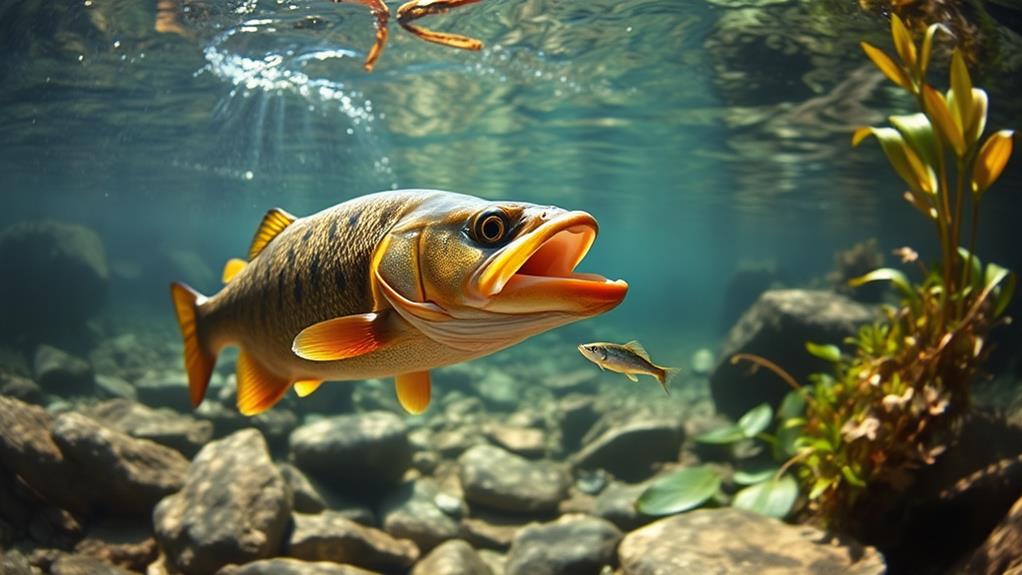
As you venture into the rocky, clear waters of the Northeast's rivers and lakes, you're likely to encounter the Smallmouth Bass (Micropterus dolomieu). This popular game fish thrives in areas with current and structure, making its home among submerged rocks and logs.
You'll recognize it by its brownish coloration and distinctive black spots, with a series of dark vertical bars along its sides. The top dorsal fin is spiny and separated from the soft-rayed rear portion.
Smallmouth Bass typically measure between 12 and 20 inches, though some can grow larger in ideal conditions. These opportunistic predators feast on crayfish, minnows, and insects, using their keen hunting skills to dominate their habitat.
When spring arrives, males construct nests in shallow waters for spawning.
If you're an angler, you'll appreciate the Smallmouth's reputation for putting up a fierce fight when hooked. Their strength and agility make them a prized catch in Northeast waters.
With a lifespan of 6 to 10 years, these fish play a vital role in their ecosystem and provide excitement for fishing enthusiasts throughout the region.
Northern Pike
In the murky depths of Northeast waters, you'll find the formidable Northern Pike (Esox lucius). This large freshwater predator is easily recognized by its elongated body and sharp teeth, typically reaching lengths of 24 to 36 inches.
You'll encounter Northern Pike in various habitats, including lakes, rivers, and marshes, where they lurk among vegetation, waiting to ambush their prey.
These opportunistic hunters aren't picky eaters. They'll devour fish, amphibians, and even small mammals up to half their body length. Juvenile Blacks and other small fish often fall victim to the Northern Pike's voracious appetite. If you're fishing for pike, using bail fish as bait can be an effective strategy.
Come early spring, when water temperatures rise above 40°F, Northern Pike begin their spawning ritual. Females lay an impressive 2,000 to 75,000 eggs in shallow, vegetated areas.
These resilient fish can live up to 15 years in the wild, with some exceptional individuals surpassing 20 years under ideal conditions. Their longevity and adaptability make Northern Pike a common sight in Northeast freshwater ecosystems.
Rainbow Trout
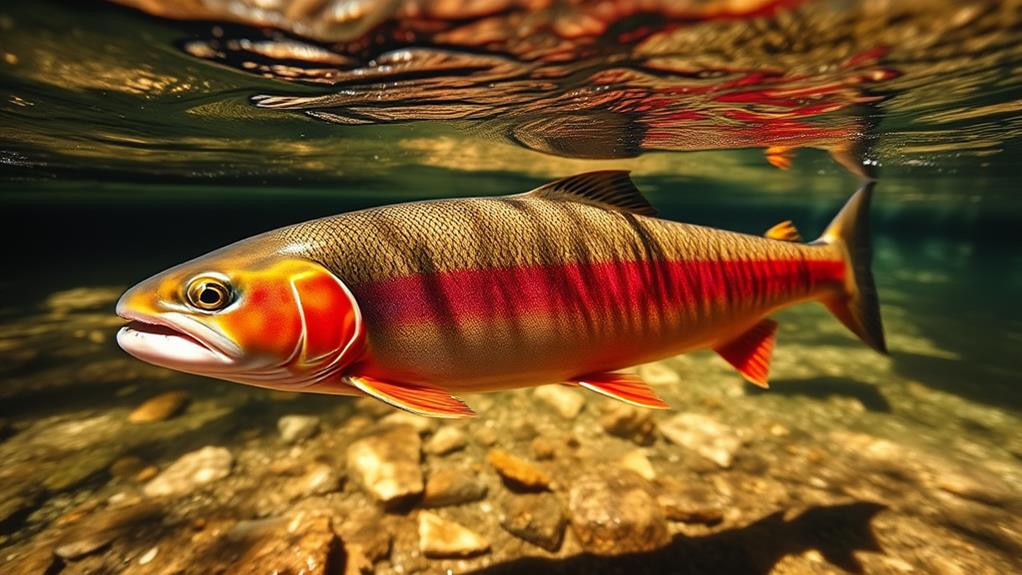
Frequently sought after by anglers, the Rainbow Trout (Oncorhynchus mykiss) graces the cold, clear streams and lakes of the Northeast. This popular Fish Species thrives in well-oxygenated waters, making it a staple in any field guide to freshwater fish. You'll typically find rainbow trout measuring between 12 to 20 inches, though some can exceed 30 inches in ideal conditions.
These fish have a relatively short lifespan, averaging 4 to 6 years, but can live up to 11 years in the wild. Come spring, females lay eggs in gravel nests, which hatch in about 3 to 4 weeks. Rainbow trout are opportunistic feeders, primarily consuming aquatic insects, crustaceans, and small fish.
| Characteristic | Description | Note |
|---|---|---|
| Size | 12-20 inches | Can exceed 30 inches |
| Lifespan | 4-6 years | Up to 11 years possible |
| Diet | Aquatic insects | Also eat crustaceans and small fish |
When you're out fishing or exploring Northeast waterways, keep an eye out for these beautiful creatures. Their presence often indicates a healthy aquatic ecosystem, and they're a joy to observe in their natural habitat. Whether you're an angler or a nature enthusiast, understanding rainbow trout behavior and habitat preferences can enhance your outdoor experiences.
Brown Bullhead
Among the diverse array of freshwater fish in the Northeast, the Brown Bullhead (Ameiurus nebulosus) stands out with its distinctive whiskers and hardy nature.
You'll find these dark brown fish in warm, shallow waters of lakes, ponds, and slow-moving streams, often hiding in muddy bottoms. With an average length of 12 to 18 inches and weighing up to 6 pounds, they're a popular target for both sport fishing and culinary enthusiasts.
Brown Bullheads are opportunistic feeders, scavenging along the bottom for:
- Invertebrates
- Small fish
- Detritus
These adaptable fish have a lifespan of 8 to 10 years and spawn in late spring to early summer.
Females lay eggs in nests they create among submerged vegetation, ensuring the survival of their offspring. As you explore the freshwaters of the Northeast, you'll likely encounter these resilient fish.
Their brown or olive coloration helps them blend into their surroundings, but their whisker-like barbels make them easy to identify.
Whether you're an angler or simply appreciate the diversity of aquatic life, the Brown Bullhead is a fascinating species to observe in its natural habitat.
Pumpkinseed Sunfish
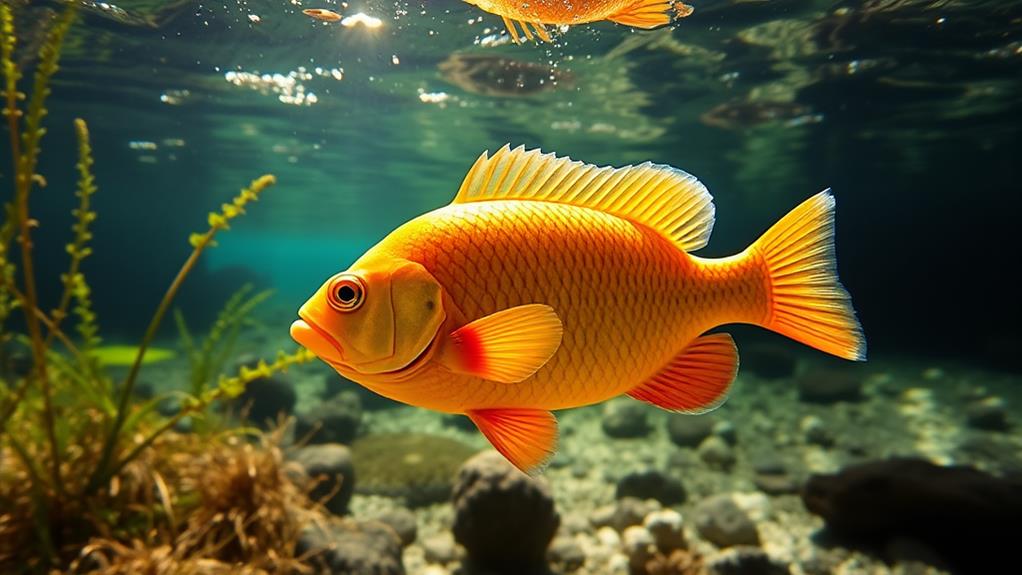
With their dazzling colors and distinctive appearance, Pumpkinseed Sunfish (Lepomis gibbosus) are sure to catch your eye in the freshwaters of the Northeast. These vibrant fish sport a blue-green body with a striking orange or yellow spot on their ear flap, making them easily identifiable.
You'll typically find pumpkinseed sunfish reaching lengths of 6 to 7 inches and living up to 7 years.
If you're exploring shallow waters during late spring or early summer, you might witness their fascinating spawning behavior. Males create nests by fanning out gravel with their tails, preparing for the arrival of females.
These fish play a vital role in their ecosystem by feeding on insects, crustaceans, and small fish, effectively controlling insect populations in freshwater habitats.
You're most likely to encounter pumpkinseed sunfish in ponds, lakes, and slow-moving rivers. They prefer areas with abundant vegetation, which provides cover and breeding grounds.
Chain Pickerel
While the Pumpkinseed Sunfish adds a splash of color to Northeast waters, another fascinating inhabitant lurks in the weedy areas: the Chain Pickerel (Esox niger). This resilient sport fish is a carnivorous predator you'll often find in lakes, rivers, and ponds throughout the region.
With its elongated body and distinctive chain-like pattern of dark green to brown spots on a black background, the Chain Pickerel is a sight to behold. Known for their ambush tactics, these fish thrive in cover, especially during prime feeding times such as early morning and late evening when they're most active best times for bass fishing.
You'll typically encounter these fish at lengths between 20 to 30 inches, and they can live up to 8 years. Known for their aggressive behavior, Chain Pickerels are primarily fish-eaters, but they won't shy away from amphibians either.
Come spring, females lay adhesive eggs in shallow waters, which hatch in about 10 days.
For anglers seeking detailed information on this species, here are some key points:
- Chain Pickerels are popular for their fighting ability
- They're often caught using lures or live bait
- Their spawning occurs in spring
Whether you're an avid fisherman or a casual observer, the Chain Pickerel offers an exciting glimpse into the diverse aquatic life of the Northeast.
Conclusion
You've now journeyed through the aquatic wonders of the Northeast, uncovering a world teeming with fins and scales! From the monstrous largemouth bass to the dazzling pumpkinseed sunfish, you're ready to conquer any fishing hole. Armed with this knowledge, you'll be catching fish by the thousands, impressing friends, and becoming a local legend. So grab your rod, bait your hook, and prepare for the most epic fishing adventure of your life!



